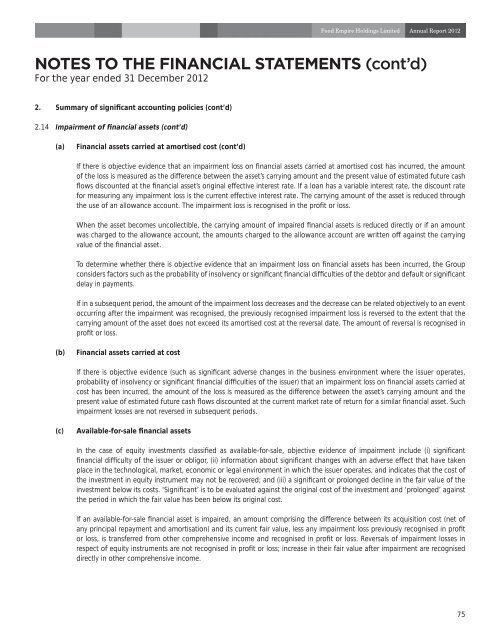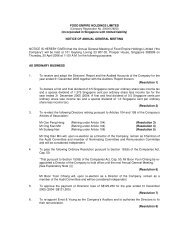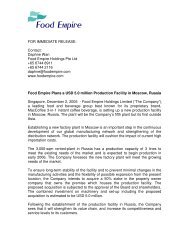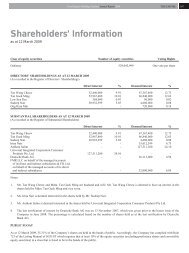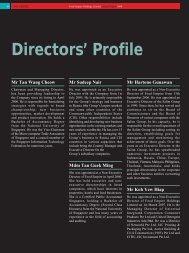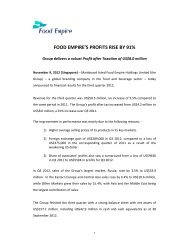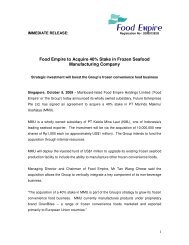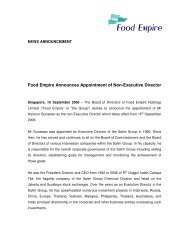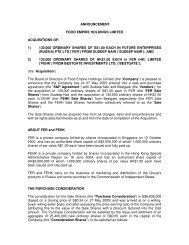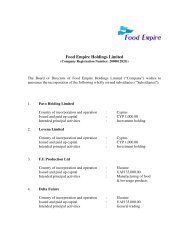notes to the financial statements - Food Empire Holdings Limited
notes to the financial statements - Food Empire Holdings Limited
notes to the financial statements - Food Empire Holdings Limited
Create successful ePaper yourself
Turn your PDF publications into a flip-book with our unique Google optimized e-Paper software.
<strong>Food</strong> <strong>Empire</strong> <strong>Holdings</strong> <strong>Limited</strong> Annual Report 2012<br />
NOTES TO THE FINANCIAL STATEMENTS (cont’d)<br />
For <strong>the</strong> year ended 31 December 2012<br />
2. Summary of significant accounting policies (cont’d)<br />
2.14 Impairment of <strong>financial</strong> assets (cont’d)<br />
(a)<br />
Financial assets carried at amortised cost (cont’d)<br />
If <strong>the</strong>re is objective evidence that an impairment loss on <strong>financial</strong> assets carried at amortised cost has incurred, <strong>the</strong> amount<br />
of <strong>the</strong> loss is measured as <strong>the</strong> difference between <strong>the</strong> asset’s carrying amount and <strong>the</strong> present value of estimated future cash<br />
flows discounted at <strong>the</strong> <strong>financial</strong> asset’s original effective interest rate. If a loan has a variable interest rate, <strong>the</strong> discount rate<br />
for measuring any impairment loss is <strong>the</strong> current effective interest rate. The carrying amount of <strong>the</strong> asset is reduced through<br />
<strong>the</strong> use of an allowance account. The impairment loss is recognised in <strong>the</strong> profit or loss.<br />
When <strong>the</strong> asset becomes uncollectible, <strong>the</strong> carrying amount of impaired <strong>financial</strong> assets is reduced directly or if an amount<br />
was charged <strong>to</strong> <strong>the</strong> allowance account, <strong>the</strong> amounts charged <strong>to</strong> <strong>the</strong> allowance account are written off against <strong>the</strong> carrying<br />
value of <strong>the</strong> <strong>financial</strong> asset.<br />
To determine whe<strong>the</strong>r <strong>the</strong>re is objective evidence that an impairment loss on <strong>financial</strong> assets has been incurred, <strong>the</strong> Group<br />
considers fac<strong>to</strong>rs such as <strong>the</strong> probability of insolvency or significant <strong>financial</strong> difficulties of <strong>the</strong> deb<strong>to</strong>r and default or significant<br />
delay in payments.<br />
If in a subsequent period, <strong>the</strong> amount of <strong>the</strong> impairment loss decreases and <strong>the</strong> decrease can be related objectively <strong>to</strong> an event<br />
occurring after <strong>the</strong> impairment was recognised, <strong>the</strong> previously recognised impairment loss is reversed <strong>to</strong> <strong>the</strong> extent that <strong>the</strong><br />
carrying amount of <strong>the</strong> asset does not exceed its amortised cost at <strong>the</strong> reversal date. The amount of reversal is recognised in<br />
profit or loss.<br />
(b)<br />
Financial assets carried at cost<br />
If <strong>the</strong>re is objective evidence (such as significant adverse changes in <strong>the</strong> business environment where <strong>the</strong> issuer operates,<br />
probability of insolvency or significant <strong>financial</strong> difficulties of <strong>the</strong> issuer) that an impairment loss on <strong>financial</strong> assets carried at<br />
cost has been incurred, <strong>the</strong> amount of <strong>the</strong> loss is measured as <strong>the</strong> difference between <strong>the</strong> asset’s carrying amount and <strong>the</strong><br />
present value of estimated future cash flows discounted at <strong>the</strong> current market rate of return for a similar <strong>financial</strong> asset. Such<br />
impairment losses are not reversed in subsequent periods.<br />
(c)<br />
Available-for-sale <strong>financial</strong> assets<br />
In <strong>the</strong> case of equity investments classified as available-for-sale, objective evidence of impairment include (i) significant<br />
<strong>financial</strong> difficulty of <strong>the</strong> issuer or obligor, (ii) information about significant changes with an adverse effect that have taken<br />
place in <strong>the</strong> technological, market, economic or legal environment in which <strong>the</strong> issuer operates, and indicates that <strong>the</strong> cost of<br />
<strong>the</strong> investment in equity instrument may not be recovered; and (iii) a significant or prolonged decline in <strong>the</strong> fair value of <strong>the</strong><br />
investment below its costs. ‘Significant’ is <strong>to</strong> be evaluated against <strong>the</strong> original cost of <strong>the</strong> investment and ‘prolonged’ against<br />
<strong>the</strong> period in which <strong>the</strong> fair value has been below its original cost.<br />
If an available-for-sale <strong>financial</strong> asset is impaired, an amount comprising <strong>the</strong> difference between its acquisition cost (net of<br />
any principal repayment and amortisation) and its current fair value, less any impairment loss previously recognised in profit<br />
or loss, is transferred from o<strong>the</strong>r comprehensive income and recognised in profit or loss. Reversals of impairment losses in<br />
respect of equity instruments are not recognised in profit or loss; increase in <strong>the</strong>ir fair value after impairment are recognised<br />
directly in o<strong>the</strong>r comprehensive income.<br />
75


